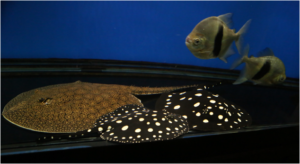Monster fish are large predatory fish that inhabit most of the inland waters of all continents of the world except Antarctica. Some of them inspire urban legends as they are nothing short of titanic in size and are capable of awe-inspiring yet scary feats such as dragging fishermen off their boats and into the dark, cold, depths of various lakes and rivers.
In some regions, some of these fish are regarded as mythological beings; folklore and countless local accounts fatal encounters with humans mesh together into stories that are simultaneously scary and legendary.

Why keep monster fish?
It is this mystique associated with them, and the idea of being able to subdue these so-called “monsters” that piques the interest of the so-called “Monster Fish Keepers.” There is also the thrill of being able to watch these majestic fish live up to their reputations in the comforts of our homes. Lastly, it is the pride one can take in being able to call an animal known for being utterly ferocious in the wild as our own pets that drives us to collect and care for our monster fish. It was in the 80s that the monster fish craze first took a huge bite out of Filipino hobbyists and sank its fangs deep into them.
At first, the craze for acquiring these exotic and gargantuan animals began with the introduction of the South American behemoths such as the Silver Arowana, Red Belly Pacu, and Redtail Catfish to the hobby. Soon, other monster fish reached our shores, such as the knifefish and giant snakehead from Asia. Towards the late 90s, the popularity of these animals reached new heights as the majestic Asian Arowanas, which were associated with luck, became increasingly available. These days, it is as if a renaissance period for these monsters has come as different species become more easily available. Ecologists need not worry, as most of these fish are already captive-bred in farms all over the world.

It is already an industry that can stand on its own as the number of importers and exporters are rising. Even here in the Philippines, the Motoro stingray, one of South America’s most popular fresh water stingrays, has already been bred by many hobbyists. Thus, this hobby is sustainable because we do not deplete the population of these animals in the wild but rather, increase the numbers of these ornamental fish in general through captive breeding.
Where are they found? As previously stated, these fish inhabit all of the continents except Antarctica. Hence, it shouldn’t come as a surprise that these fish are of various forms and sizes. For example, one of our local favorites, the Jardini Arowana, and the extremely rare air-breathing Australian Lungfish come from Australia.

The fabled man-eating Wels Catfish can be found throughout Europe. The Alligator Gar, which has been in existence since the early Cretaceous period over a hundred million years ago (when dinosaurs roamed the earth), still patrols the waters of North America. The Goliath Tiger Fish, the meter-long cousin of the piranha which is known to take chunks out of Nile crocodiles, still thrives in Africa. Asia is home to the elegant Red and Golden Arowana, which are often associated with luck. Then there is South America; the entire stretch of the Amazon is the breeding ground of various freshwater stingrays, home to a lot of giant-sized catfish and one of the biggest freshwater fish in the world, the giant Arapaima.
Not for beginners Caring for these fish, though, is not without its special challenges. First and foremost, you have to be ready with a big fish tank. Often, the standard 75-gallon aquarium is a starting point. However, a lot of species will be able to outgrow this tank, which will lead to the owner having to upgrade to bigger tanks or ponds. Some species also present risks to their owners, such as stingrays with venomous barbs; even if not fatal, these can leave a very painful wound. Hence, special considerations and precautions must be taken into account to be able to house these animals.

If a keeper has multiple species, they will require different diets as some of them will not take the pellets or fish flakes other fish will happily consume. Also, monster fish have monster appetites. Thus, they often prefer meaty and protein-rich food such as tawilis, shrimp, and beef heart. There are also some which are piscivorous and will only eat smaller live fish.
Big communities
With a plethora of monsters available in the trade, usually, one does not keep a solitary specie in a tank for long. As people progress in the hobby and gain more knowledge and experience of various species, they are able to create communities of different species from different regions of the world in order to create a truly monster fish community.
These fish are truly majestic and are always a sight to behold. They are sure to spark conversations as soon as they are seen. However, research, and investments in equipment, in care practices, and time for keeping your water parameters pristine are needed in order to successfully rear these animals. Being a monster fish keeper is akin to being an extreme angler, an aquatic biologist, and sometimes, even a lion tamer—while staying in the comforts of your home.
So if you think you are brave enough to be called a monster fish keeper, we invite you to dive into the exhilarating world of monster fish keeping.
This appeared in Animal Scene’s January 2016 issue.






